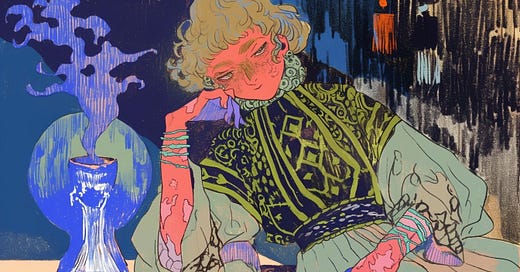Cult Classics Cellar
Our private collection - a continuously updated list of our "Cult Classic" wines
There are those wines that anyone would be impressed by - big names, hefty price tags - but then there are those wines which only those really “in the know” about wine know. These are our “Cult Classics,” and they’re the producers you should know and try as you develop your own taste in wine.
This cellar is continuously updated to reflect our ever-growing list, and includes wines which have yet to be featured on my socials. Right now, the producers are listed in alphabetical order, but I’ll almost certainly re-order them as our list grows.
I still have thousands of wines to taste and assess for this list so, if you think there’s one I should consider adding to our cellar, add a comment here or on my socials! I’m all ears!
Also, I try to keep the lists of where to find and order these wines as accurate as possible, but please keep in mind that most of these wines are produced in low quantities and each store receives a limited allocation. I have listed where you are most likely to find them at any given point in time, but availability and allocation are highly variable.
ALBERT BOXLER
Dominant Style: Still whites (dry and off-dry)
Origin: AOC Alsace Grand Cru, Alsace, France
Principal Grape Varietals Used: Riesling, Pinot Gris, Gewürztraminer, Muscat, Pinot Blanc
Farming and Production Methods: Organic, biodynamic, minimal intervention
Price Range: Entry-level wines beginning at ~$40, Grand Cru and aged wines up to ~$150
Where to Find Them:
New York: Flatiron Wines, Chambers Street Wines
Los Angeles: K&L, Lincoln Fine Wines
Chicago: Perman Wine Selections
U.S. Shipping: Kermit Lynch, Wine.com
Why it’s a Cult Classic: There are a handful of Alsace producers who manage to balance Old World structure and electric energy, and Albert Boxler is at the top of that list. Based in the tiny village of Niedermorschwihr, this estate dates back to the 17th century, but it was Jean Boxler who cemented its modern reputation. Boxler’s Rieslings and Pinot Gris—especially from the iconic Grand Cru Sommerberg and Brand vineyards—show piercing acidity, deep minerality, and an unshakable sense of place. These are serious wines built for aging, but the floral aromatics and citrus-driven vibrancy make them irresistible even in their youth. If you want to understand what makes Alsace special, start here.
ALZINGER
Dominant Style: Still whites (dry)
Origin: Wachau DAC, Niederösterreich, Austria
Principal Grape Varietals Used: Grüner Veltliner, Riesling
Farming and Production Methods: Sustainable, minimal intervention
Price Range: Entry-level Federspiel wines starting at ~$40, Smaragd wines up to ~$120
Where to Find Them:
New York: Chambers Street Wines, Flatiron Wines
Los Angeles: Wally’s, K&L Wines
Chicago: Vin Chicago
U.S. Shipping: Wine.com
Why it’s a Cult Classic: If Austrian wine had a hall of fame, Alzinger would be in the first class of inductees. A small, family-run estate with holdings in some of the Wachau’s most prestigious vineyards—Loibenberg, Höhereck, and Steinertal—Alzinger crafts wines of laser-like precision and stunning finesse. Their Grüner Veltliners are textbook examples of the grape’s peppery, herbal character, while the Rieslings are crystalline and racy, built for decades of aging. The Smaragd-designated wines (the most sought after wines in Wachau) are particularly prized, showcasing depth and structure without ever feeling heavy.
AMOROTTI
Dominant Style: Still reds, whites, and rosés
Origin: Loreto Aprutino, Abruzzo, Italy (Montepulciano d’Abruzzo DOC, Trebbiano d’Abruzzo DOC, Cerasuolo d’Abruzzo DOC)
Principal Grape Varietals Used: Montepulciano, Trebbiano
Farming and Production Methods: Organic (biodynamic leaning), low-intervention
Price Range: From ~$45+
Where to Find Them:
New York: Chambers Street Wines, Astor Wines, Eataly Vino, Flatiron Wines
Los Angeles: Thatcher’s Wine, K&L Wines, The Wine House
Chicago: Perman Wine Selections, Eataly Vino (likely)
U.S. Shipping: Select online retailers specializing in artisanal Italian wines (e.g., Eataly Vino’s online store, some natural wine shops)
Why it’s a Cult Classic: Amorotti is a leader of the new wave redefining Abruzzo’s wine reputation. It’s known for outstanding reds from the Montepulciano grape and crisp, mineral-driven Trebbiano. Because the quality of its fruit is so high, and the biodiversity in the vineyard so vast, they’re able to take a hands-off approach, letting indigenous yeasts and careful farming coax out regional character. Amorotti’s Cerasuolo rosé (which I have yet to try, but I’ve heard some say is more like a very light red) has also earned a devout following for its savory and bright fruit. Amorotti’s tiny, family-run operation shows how terroir-focused, biodynamic methods can elevate Abruzzese wines to another level. Amorotti is often thought of as the more affordable counterpart to mysterious, pricier cult wine, Valentini. The comparison goes further than the two of them making great wines in hills of Abruzzo. The vineyards are next door neighbors in the town of Loreto Aprutino, and when the owner of the Amorotti farm made the decision to produce and bottle his own wine, it was Valentini who helped with clonal selections in the vineyards, barrel selections for the cellar and more.








